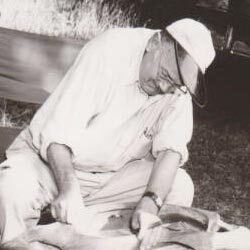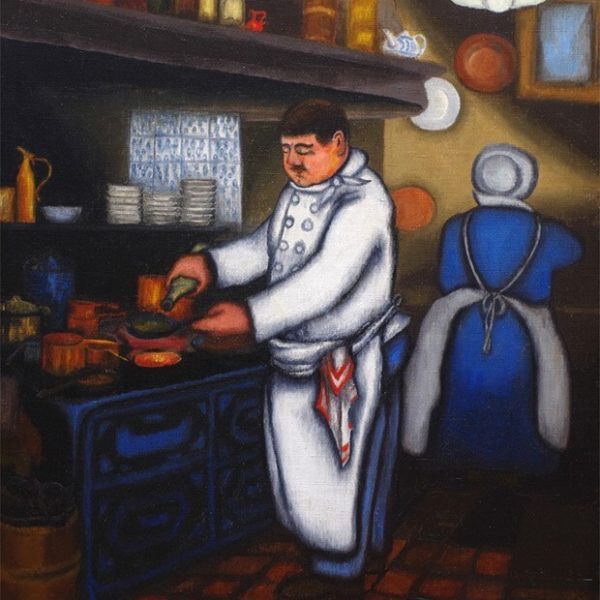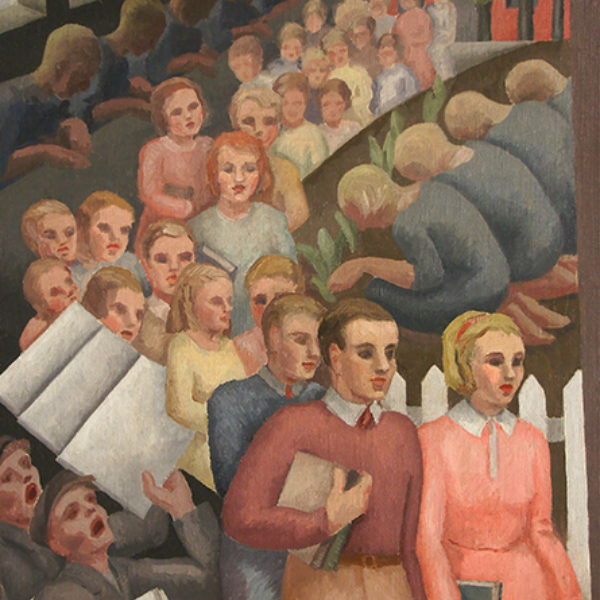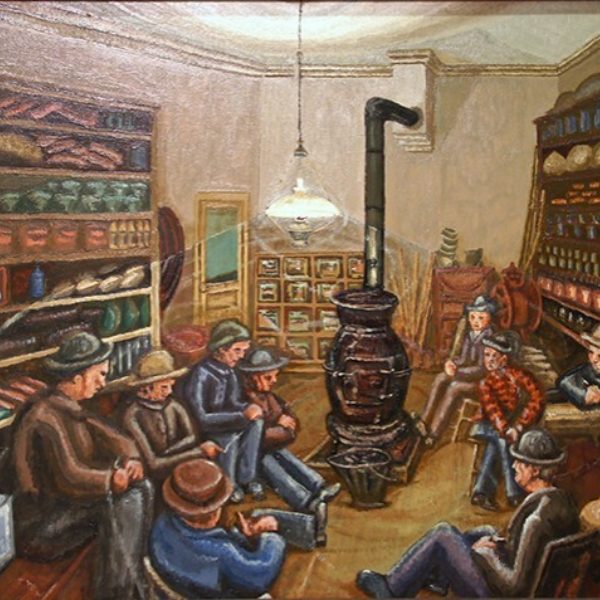
Vinol Hannell
b. 1896, Negaunee, MI - d. 1964, Chicago, IL
Vinol “Vin” Hannell was born in 1896 in Negaunee, Michigan, but spent most of his youth with his father’s family in Finland. Just one year old when he visited there with his mother and sister, Hannell fell ill and remained behind in the care of an aunt and uncle. He studied art at the Academy of Fine Arts of Åbo.
In his early teens, Hannell returned to the United States and served in the US Navy medical corps before enrolling in the School of the Art Institute of Chicago (SAIC). There, in 1919 and 1920, he studied with visiting professors George Bellows and Randall Davey, who advocated the realist techniques they had learned from Robert Henri, including an interest in everyday subjects and urban life, and anti-academic views. Hannell met his future wife, Hazel, at SAIC and the two artists married in 1923. The Hannells settled on the South Side of Chicago, and for a time lived at Jane Addams’s Hull-House. Along with Myrtle and Beals French, the Hannells provided $750 of initial capital to establish the Hull-House Kilns “factory” operation and the Hull-House Shop. Vin and Hazel also befriended fellow artist couples Frances Strain and Fred Biesel and Frances Foy and Gustaf Dalstrom, with whom they traveled to Europe in 1928. Visits to Strain and Biesel’s home in Furnessville, Indiana, during the 1920s prompted the Hannells to purchase property there and build a summer home. During the Depression, when it was no longer possible to maintain two households, the Hannells relocated permanently to Furnessville.
The move to Indiana did not derail Vin’s participation in the Chicago art scene during the 1920s and 1930s. He showed his oil paintings and watercolors at the Art Institute of Chicago between 1923 and 1951, receiving an award in 1934 for Bouquet. He also joined the efforts of several anti-institutional groups, exhibiting his work with the Society of Independent Artists in the 1920s, the Chicago Society of Artists from 1926 to 1935, and the Chicago No-Jury Society of Artists. Hannell was one of the original members of Ten Artists, an organization established in Chicago in 1929 by Strain and Biesel and eight other “sane Modernists.” The group organized numerous shows through the 1930s, including two open-air art fairs in 1932 and 1933. He and Hazel designed the interior of the Victor Vienna Café at the Century of Progress Exposition in 1933–34.
In his genre painting Hot Stove Club of 1941, Hannell presented a scene of everyday life in middle America: men and boys gather companionably in a general store around a potbelly stove in the center of the room. Dressed simply in sturdy jackets, trousers, and hats, they embody the virtues of plain living in rural America. Fueled by coal in the metal bucket at its feet, the bulging cast-iron stove radiates heat. Its warmth, along with the gentle glow of light from a lone pendant lamp above, imbues the scene with a cozy, communal atmosphere. Towering shelves along the side walls stocked with countless packages, bags, and tins of dry goods, signal the store’s importance as the lifeblood for small-town residents. A vibrant spectrum of blues, greens, reds, and warm brown tones enhance the image’s pleasant associations. In its reassuring depiction of small-town life and naturalist style, Hannell’s depiction conveys a sense of nationalism and nostalgia akin to the work of American scene painters in the wake of the Depression.
From the 1940s until his death in 1964, Hannell painted less, and focused more on wood sculpture and the pottery business he and Hazel ran jointly. From their studio in Chesterton, Indiana, they produced informal tableware and decorative accessories, availing themselves of the native red clay. A partnership in the early 1940s with designer-distributors Clem and Nixon Hall of New York brought the Hannells’ pottery to retail markets across the country. Vin and Hazel contributed to a flourishing art community in northwest Indiana as founding members of the Association of Artists and Craftsmen of Porter County, which sponsors the annual Chesterton Art Fair.
Patricia Smith Scanlan
References
Falk, Peter Hastings, ed. The Annual Exhibition Record of the Art Institute of Chicago, 1888–1950. Madison, CT: Soundview Press, 1990.
———, ed. Who Was Who in American Art 1564–1975: 400 Years of Artists in America. Vol. 2. Madison, CT: Soundview Press, 1999.
Ganz, Cheryl R., and Margaret Strobel, eds. Pots of Promise: Mexicans and Pottery at Hull-House, 1920–40. Urbana: University of Illinois Press and Jane Addams Hull-House Museum Chicago, 2004.
Hannell, V. M. S. Pamphlet File P-00777. Ryerson Library. Art Institute of Chicago. [2 items]
Weininger, Susan. Hazel and Vin Hannell: Two Lives in Art. Valparaiso, IN: Valparaiso University Museum of Art, 1994.
———. “‘The Spirit of Change’: Modernism in Chicago” and “Carl Hoeckner.” In Chicago Painting 1895 to 1945: The Bridges Collection. Urbana: University of Illinois Press with the Illinois State Museum, 2004.
Yochim, Louise Dunn. Role and Impact: The Chicago Society of Artists. Chicago: Chicago Society of Artists, 1979.
Artist image: Westchester Township History Museum, Chesterton, IN.


